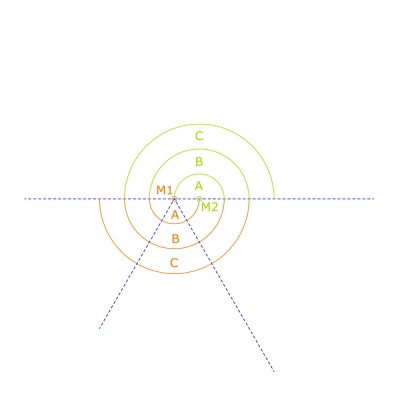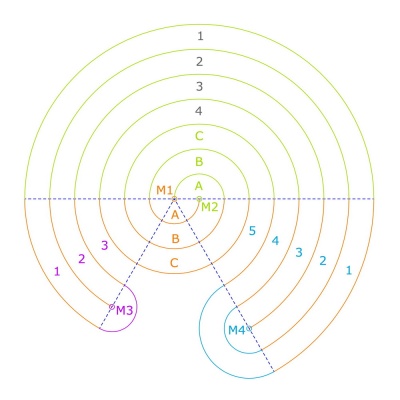A Wunderkreis is a double spiral, surrounded by a simple labyrinth with two turning points.
We begin in the centre with the double spiral. One semicircle below and one semicircle above the horizontal line would suffice as a minimum. Many more semicircles could be added to enlarge the double spiral. Here we make three arcs which we name A, B and C. The lower ones are drawn around M1 as the centre, the upper ones are arranged around M2 as the centre and shifted to the right.
Then we add three arcs on the left side. They are drawn in a triangular sector around the midpoint M1. We number the circuits from the outside with 1, 2 and 3. Circuit 3 will finally form the entrance.
The turning and midpoint M3 for the lower semicircle lies concentric between the both external circuits 1 and 2.
Now we go to the right side. Here two arcs more than on the left side are necessary, that means a total of five. Again we number the circuits from the outside inwards from 1 to 5. The circuit 5 will later lead to the exit.
The turning point M4 lies concentric between the four circuits 1 to 4. In the lower middle section two semicircles are traced around that midpoint M4.
Now the upper semicircles are completed around the midpoint M2. There are four semicircles (and circuits) more on each side than at the beginning.
The Wunderkreis is usually entered through the labyrinthine circuits on circuit 3 and left through the double spiral on circuit 5. The path sequence then is as follows: 3-2-1-4-C-B-A-A-B-C-5.
The path sequence 3-2-1-4 forms the basis of the meander, as connoisseurs know, as in the Knossos labyrinth.
Now we choose more circuits and apply the abovementioned principles to the construction. Through that Wunderkreise with a varied number of circuits can be generated. We can add circuits to the double spiral one by one, to the labyrinth we have to do it in pairs.
On the right side two circuits more are necessary than on the left. The lower turning points (M3 and M4) must lie concentric between the even-numbered left or right circuits. In the following example we have 6 circuits on the left and 8 on the right side.
If we know how many circuits for a Wunderkreis we want, we can lay both lower turning points on a line and determine the middle for the double spiral (M1) in a triangle. Entrance and exit can also be arranged side by side without any space.
Nevertheless we can begin, while marking out, with the definition of the middle M1 and also determine the adjustment of the main axis (vertical line). The remaining centres M3 and M4 can afterwards be fixed in that triangle.
Best of all we consider the measurements as units, so either “metre” or “yard” or “step width” or something similar. Then we can also scale all dimensions.
The smallest radius begins with 1 unit and then gradually grows by 1 from arc to arc. Then the biggest radius has 12 units. The boundary lines add themselves on 407 units, the whole way through the Wunderkreis reaches 362 units.
In this example the Wunderkreis has four circuits more than in the other at the top of the page and no space between entrance and exit. This area is formed quite differently in the historical Wunderkreise. Sometimes the paths are joined together, sometimes they run apart.
Related Posts







Pingback: How to Make an Aligned Wunderkreis | blogmymaze
Pingback: How to make a Wunderkreis, Part 2 | blogmymaze
Pingback: How to make a Wunderkreis or a Baltic Wheel | blogmymaze
Pingback: How to make a Babylonian Wunderkreis | blogmymaze
Pingback: How to make a Babylonian Wunderkreis, Part 1 | blogmymaze
Pingback: How to Make a Baltic Wheel from a Wunderkreis | blogmymaze